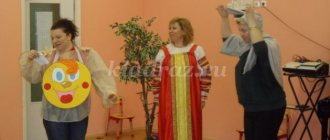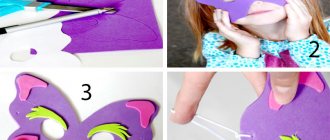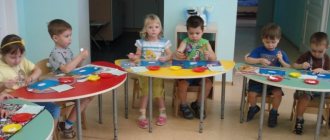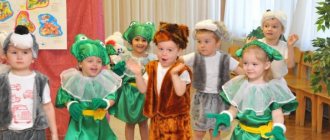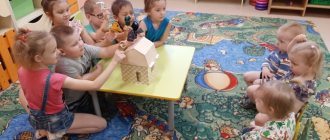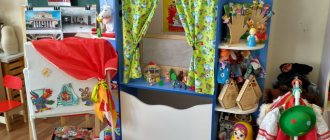“Do-it-yourself puppet theaters for preschoolers” - presentation
“Do-it-yourself puppet theaters for preschoolers” Educator: Nadyrova G.P. MBDOU D. S. "ROCKET" BRANCH 2 D. S. "SNOWFLAKE" GERMAN NATIONAL DISTRICT ALTAI REGION
Theatrical activities play an important role in the formation of a child’s personality. The theater attracts with its brightness, colorfulness, dynamics, affects the audience, and brings a lot of joy. Various types of puppet theaters comprehensively develop preschoolers, help them understand the content of a literary work more easily and clearly, and influence the development of artistic taste. The most interesting theaters for children are those made by teachers and parents. I present to your attention our creativity.
The pom-pom theater is one of them. Thanks to the wide range of color options, you can get a more accurate image of the characters. I present to your attention the heroes of the fairy tale “The Cat, the Rooster and the Fox”
The finger theater is unique in that it can be placed on the child’s palm. Theater is also an excellent speech and sensory-motor trainer. Dolls influence the development of both hands, help enrich and develop vocabulary, and master the speech of characters. Finger theater develops attention, fantasy, imagination, memory, creative and artistic abilities.
The theater of pictures begins with flannelography. In kindergartens, the most popular is the theater of pictures, divided into pictures on flannel (flannel) or Velcro. It is the easiest to display and manufacture. The pictures on the flannel and the decorations are flat. They are shown on a special board located on the table. I would like to present to your attention a theater on a flannelgraph made from felt napkins, which was made by Sonya Kovalenko’s mother and grandmother. Heroes of the fairy tale "Masha and the Bear"
Collective theatrical activity using theater on glasses and lids develops the communicative qualities of an individual, helps to master the ABCs of relationships, teaches conflict resolution through play, and helps to empathize with the characters. In addition, speech, memory, attention, thinking, logic, coordination of movements, fine motor skills, and creative abilities develop.
Puppet - a doll walking on the floor; threads are attached to her head, legs and arms, with the help of which she is led by an actor located above her on a special platform. The puppet theater is set in motion with the help of a vaga - a cross, to which the doll is attached with the help of threads. The floor view of the puppet theater contributes to the development of creative imagination, develops the ability to wield a puppet, improvise, etc. Puppets - puppets in our group appeared already in 2010, thanks to grandmother Panibratets Lyubov Nikolaevna, who made the characters based on Krylov’s fable “The Dragonfly and the Ant”
The mask theater is suitable for children of any age. Even the youngest pupils have the opportunity to “reincarnate” into the hero of a fairy tale.
Through the fan theater, the child is imbued with good feelings, experiences together with the heroes of fairy tales, and at the same time comprehends the simple and complex, instructive and amazing truth of life.
Children enjoy participating in theatrical activities using a theater on clothespins.
Theater is a magical world. He gives lessons in beauty, morality and ethics. And the richer they are, the more successful the development of the spiritual world of children is... (B. M. Teplov)
Presentation “Getting to know the theater” presentation for the lesson (senior group) on the topic
Conversation for the virtual trip “Getting to know the theater.”
Goal: To develop interest in the theater and theatrical activities.
Tasks:
- Expand children's knowledge about theater as a type of art;
- Strengthen your knowledge of theaters;
- Continue to introduce theatrical terminology (actor, director, lighting designer, costume designer, make-up artist);
- Activating children's speech through the development of dialogic conversation, introducing new words and concepts into the active vocabulary (Foyer, spotlights);
- Fix the text of S. Marshak’s poem “In the Theater for Children”;
- To consolidate knowledge of the professions of people serving in the theater;
- Foster a culture of communication between children, children and adults;
- Continue to develop the ability to comply with the rules of behavior in the theater.
Material: electronic presentation “Getting to know the theatre.”
Preliminary work: looking at photographs of the theater.
Activation of the dictionary: wardrobe, cloakroom attendant, foyer, usher, orchestra pit, director, actor, role, prop man, make-up artist, applause, costume designer, artist, cashier. Progress of the conversation:
Educator: Children, today we will talk about the theater. What is theater?
Children: The theater is an amazing house where they show performances, fairy tales, where they dance and sing, and recite poems.
Educator: Guys, have you been to a real theater?
Children: No.
Educator: Why do you think people go to the theater?
Children: Adults and children go to the theater to watch a play, a fairy tale, listen to music, learn new things, and relax.
Educator: Every visit to the theater is a holiday! The word THEATER came to us from the Greek language and means “place for spectacle, spectacle.” But theater is not only an art form, but also a building where we come to performances. Want to know more about theatre? Children: Yes. Educator: Let's go to the theater. And I will be your tour guide. I invite you on a tour! Slide 1 INTRODUCTION TO THE THEATER Educator: Theaters come in different genres: theaters in which the actors do not talk, but sing, and their singing, stage action and actions are consistent with music written specifically for this play - this is opera.
Slide 2 OPERA AND BALLET THEATER
Slide 3 OPERA In opera they do not speak, but sing. What an opera singer sings is called an aria.
Theaters in which the actors do not talk, but dance, and all feelings are expressed through dance movements - this is ballet. Slide 4 BALLET Ballet dancers tell the audience about all the events and relationships of the characters with each other through dance.
Slide 5 Many wonderful operas and ballets are based on fairy tales. Alice in Wonderland The Nutcracker The Tale of Tsar Saltan
Slide 6 DRAMATIC THEATER In a drama theater, actors talk. The playwright talks about the characters and events in the play through dialogues.
Slide 7 THEATER OF ANIMALS
The oldest theater exists in Moscow - the theater of V. L. Durov. “Grandfather Durov’s Corner” where animals perform: hippopotamus, elephant, raven, pelican, raccoon and many others.
Slide 8 PUPPET THEATER There are puppet theaters where spectators look not at live actors, but at puppets controlled by the artists. Slide 9 GLOVE DOLLS Slide 10 PUPPETS
Slide 11 SHADOW THEATER
Slide 12 FOYER
Slide 13 AUDITORIUM Let's look at the auditorium. The most important place in the auditorium is the stage on which the performance is performed. The scene itself is not yet visible. It is still closed with a curtain. If you are sitting far from the stage, you will need theater binoculars, which you can bring with you or purchase from the cloakroom. PARTERRE BENOIR MEDIUM FLOORS 1st TIERC 2nd TIERC BALCONY
Slide 14 ORCHESTRA PIT. Musical operas and ballets, in opera the artists sing, they are called soloists, and they are assisted by choreographers and an orchestra. The orchestra is led by a conductor so that the musicians play in the same rhythm and tempo, and in ballet the artists dance. A choreographer helps them in staging the dance. The musicians are sitting in the orchestra pit. The orchestra pit is a special room for the orchestra in the theater, located in front of the stage.
Slide 15 CURTAIN What is a theater curtain? This is a canvas that covers the stage from the audience. The performance will begin as soon as the curtain rises or moves apart, as they are sliding or rising.
Slide 16 DECORATIONS The scenery for the performance is made in the workshop according to the sketches of the decorative artists.
Slide 17 The scenery for the performance is made in the painting and decoration workshop according to the artists’ sketches.
Slide 18 PROPERTIES Props are fake, specially made objects of sculpture, furniture, and dishes used in theatrical performances instead of real things. A theater worker who makes props is called a prop maker. Crockery, food, weapons, and furniture can be props.
Slide 19 SPOTLIGHTS With the help of spotlights, lighting designers can depict a sunrise or sunset, flashes of lightning, a starry sky and much more on stage.
Slide 20 During a performance, a sound engineer can turn on a soundtrack: the sound of rain or the roar of waves, the roar of the crowd or the whistle of the wind - depending on what is happening on stage at that time.
Slide 21 Before the performance, the make-up artist applies makeup to the actors. An experienced master can change an actor's face beyond recognition.
Slide 22 Actors for a performance may need a variety of costumes - ancient, modern, and even fairy-tale. The entire costume must first be designed and then drawn by the artist. The tailors will then bring his ideas to life. Masters can paint a piece of burlap in such a way that from the audience it will seem like rich brocade, velvet or silk.
-And the most important person who runs the whole performance is the director. He chooses which play to stage, assigns roles, organizes and conducts rehearsals and everything that happens on stage.
Slide 23 DIRECTOR The director also chooses which play to stage, works with the production designer, and organizes everything that happens on stage.
Slide 24 Finally, the performance is ready, and the theater invites the audience. The new performance is called the premiere. So, you and I are spectators. The performance will begin soon and it’s time for us to go to the auditorium. But what is it? (Bell) Which of you is the most attentive and heard an unusual sound? This is a theatrical call. In total, the theater rings three bells before the start of the performance. The third bell indicates that the performance is beginning. After the third ring, the lights in the hall go out. It is indecent to enter the auditorium after the third bell.
Slide 25Applause! Educator: Our excursion has come to an end, did you enjoy the trip? Children: Yes. Educator: What did you like most? Let's remember where we've been? What did you see? Well done! You were attentive, it's time to return to kindergarten.
